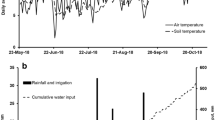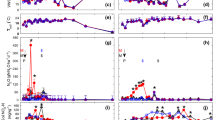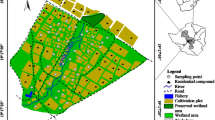Abstract
Nitrous oxide (N2O) emissions to the atmosphere from grazed pasture can be high, especially from urine-affected areas. When pastoral soils are damaged by animal treading, N2O emissions may increase. In New Zealand, autumn-sown winter forage crops are often grown as a break-crop prior to re-sowing pasture. When these crops are grazed in situ over winter (as is common in New Zealand) there is high risk of soil damage from animal treading as soil moisture contents are often high at this time of year. Moreover, the risk of soil damage during grazing increases when intensive tillage practices are used to establish these forage crops. Consequently, winter grazed forage crops may be an important source of N2O emissions from intensive pastoral farming systems, and these emissions may be affected by the type of tillage used to establish them. We conducted a replicated field experiment to measure the effects of simulated cattle grazing (mowing followed by simulated treading and the application of synthetic urine) at three soil moisture contents (< field capacity, field capacity and > field capacity) on measured N2O emissions from soil under an autumn (March) sown winter forage crop (triticale) established with three levels of tillage intensity: (a) intensive, IT, (b) minimum, MT, or (c) no tillage, NT. In all treatments, bulk density in the top 7.5 cm of the soil was unaffected by treading when simulated grazing occurred at < field capacity. It was increased in the IT plots by 13 and 15% when treading occurred at field capacity and > field capacity, and by 10% in the MT plots trodden at > field capacity. Treading did not significantly increase the bulk density in the NT plots. Emissions of N2O from the tillage treatments decreased in the order IT > MT > NT. N2O emissions were greatest from plots that were trodden at > field capacity and least from plots trodden at < field capacity. Simulated treading and urine application increased N2O emission 2 to 6-fold from plots that had no treading but did receive urine. Urine-amended plots had much greater emissions than plots that had no urine. Overall, the greatest emission of 14.4 kg N ha−1 over 90 days (1.8% of the total urine N applied) was measured from urine-amended IT plots that were trodden at > field capacity. The N2O emission from urine-amended NT plots that were trodden at < field capacity was 2.0 kg ha−1 over 90 days (0.25% of the total urine N applied). Decreasing the intensity of tillage used to establish crops and restricting grazing when soils are wet are two of the most effective ways to minimise the risk of high N2O emissions from grazed winter forage crops.





Similar content being viewed by others
References
Ball BC, Campbell DJ, Douglas JT, Henshall JK, O’Sullivan MF (1997) Soil structural quality, compaction and land management. Eur. J Soil Sci 48:593–601
Ball BC, Parker JP, Scott A (1999a) Soil and residue management effects on cropping conditions and nitrous oxide fluxes under controlled traffic in Scotland 2. Nitrous oxide, soil N status and weather. Soil Till Res 52:191–201
Ball BC, Scott A, Parker JP (1999b) Field N2O, CO2 and CH4 fluxes in relation to tillage, compaction and soil quality in Scotland. Soil Till Res 53:29–39
Bhandral R, Saggar S, Bolan NS, Hedley MJ (2007) Transformation of nitrogen and nitrous oxide emission from grassland soils as affected by compaction. Soil Till Res 94:482–492
Bremner JM (1997) Sources of nitrous oxide in soils. Nutr Cycl Agroecosys 49:7–16
Clough TJ, Ledgard SF, Sprosen MS, Kear MJ (1998) Fate of 15N labelled urine on four soil types. Plant Soil 199:195–203
de Klein CAM, van Logtestijn RSP (1994) Denitrification and N2O emission from urine-affected grassland soil. Plant Soil 163:235–241
de Klein CAM, Ledgard SF (2005) Nitrous oxide emissions from New Zealand agriculture—key sources and mitigation strategies. Nutr Cycl Agroecosys 72:77–85
de Klein CAM, Barton L, Sherlock RR, Li Z, Littlejohn RP (2003) Estimating a nitrous oxide emission factor for animal urine from some New Zealand pastoral soils. Aust J Soil Res 41:381–399
Di H, Cameron KC, Milne J, Drewery JJ, Smith NP, Hendry T, Moore S, Reijnen B (2001) A mechanical hoof for simulating animal treading under controlled conditions. New Zeal J Agric Res 44:111–116
Dobbie KE, Smith KA (2003) Nitrous oxide emission factors for agricultural soils in Great Britain: the impact of soil water-filled pore space and other controlling variables. Global Change Biol 9:204–218
Douglas JT, Crawford CE (1993) The response of a ryegrass sward to wheel traffic and applied nitrogen. Grass Forage Sci 48:91–100
Drewry JJ, Paton RJ (2005a) Effects of sheep treading on soil physical properties and pasture yield of newly sown pastures. New Zeal J Agric Res 48:39–46
Drewry JJ, Paton RJ (2005b) Soil physical quality under cattle grazing of a winter-fed brassica crop. Aust J Soil Res 43:525–531
Drewry JJ, Cameron KC, Buchan GD (2001) Effect of simulated dairy cow treading on soil physical properties and ryegrass pasture yield. New Zeal J Agric Res 44:181–190
Elmi AA, Madramootoo C, Hamel C, Liu A (2003) Denitrification and nitrous oxide to nitrous oxide plus dinitrogen ratios in the soil profile under three tillage systems. Biol Fert Soils 38:340–348
Flechard CR, Neftel A, Jocher M, Ammann C, Fuhrer J (2005) Bi-directional soil/atmosphere N2O exchange over two mown grassland systems with contrasting management practices. Global Change Biol 11:2114–2127
Flechard CR, Ambus P, Skiba U, Rees RM, Hensen A, van Amstel A, van den Pol-van Dasselaar A, Soussana JF, Jones M, Clifton-Brown J, Raschi A, Horvath L, Neftel A, Jocher M, Ammann C, Leifeld J, Fuhrer J, Calanca P, Thalman E, Pilegaard K, Di Marco C, Campbell C, Nemitz E, Hargreaves KJ, Levy PE, Ball BC, Jones SK, van de Bulk WCM, Groot T, Blom M, Domingues R, Kasper G, Allard V, Ceschia E, Cellier P, Laville P, Henault C, Bizouard F, Abdalla M, Williams M, Baronti S, Berretti F, Grosz B (2007) Effects of climate and management intensity on nitrous oxide emissions in grassland systems across Europe. Agr Ecosyst Environ 121:135–152
Hamza MA, Anderson WK (2005) Soil compaction in cropping systems—a review of the nature, causes and possible solutions. Soil Till Res 82:121–145
Hansen S, Maehlum JE, Bakken LR (1993) N2O and CH4 fluxes in soil influenced by fertilization and tractor traffic. Soil Biol Biochem 25:621–630
Hewitt AE (1993) New Zealand soil classification. Manaaki Whenua—landcare research New Zealand Ltd., Lincoln, New Zealand, p 133
Hutchings NJ, Olesen JE, Petersen BM, Berntsen J (2007) Modelling spatial heterogeneity in grazed grassland and its effects on nitrogen cycling and greenhouse gas emissions. Agr Ecosyst Environ 121:153–163
Hutchinson GL, Mosier AR (1981) Improved soil cover method for field measurement of nitrous oxide fluxes. Soil Sci Soc Am J 45:11–316
IPCC (1997) Revised 1996 IPCC guidelines for national greenhouse gas inventories. IPCC/OECD/IEA, UK Meteorological Office, Bracknell
Linn DM, Doran JW (1984) Effect of water-filled pore space on carbon dioxide and nitrous oxide production in tilled and non-tilled soils. Soil Sci Soc Am J 48:1267–1272
Lipiec J, Hatano R (2003) Quantification of compaction effects on soil physical properties and crop growth. Geoderma 116:107–136
McTaggart IP, Douglas JT, Clayton H, Smith KA (1997) Nitrous oxide emission from slurry and mineral nitrogen fertilizer applied to grassland. In Gaseous nitrogen emissions from grasslands. CAB International, Wallingford, pp 201–209
Menneer JC, Ledgard SF, McLay C, Silvester WB (2005a) Animal treading stimulates denitrification in soil under pasture. Soil Biol Biochem 37:1625–1629
Menneer JC, Ledgard SF, McLay CDA, Silvester WB (2005b) The effects of treading by dairy cows during wet soil conditions on white clover productivity, growth and morphology in a white clover-perennial ryegrass pasture. Grass Forage Sci 60:46–58
Müller C, Sherlock RR (2004) Nitrous oxide emissions from temperate grassland ecosystems in the northern and southern hemispheres. Global Biogeochem Cy 18(GB1045):1–11
Neftel A, Flechard C, Ammann C, Conen F, Emmenegger L, Zeyer K (2007) Experimental assessment of N2O background fluxes in grassland systems. Tellus B 59:470–482
New Zealand Climate Change Office (2003) National inventory report New Zealand, greenhouse gas inventory 1990–2001. New Zealand Climate Change Office, Wellington, p 148
Oenema O, Velthof GL, Yamulki S, Jarvis SC (1997) Nitrous oxide emissions from grazed grassland. Soil Use Manage 13:288–295
Or D, Ghezzehei TA (2002) Modeling post-tillage soil structural dynamics: a review. Soil Till Res 64:41–59
Ruser R, Flessa H, Schilling R, Steindl H, Beese F (1998) Soil compaction and fertilization effects on nitrous oxide and methane fluxes in potato fields. Soil Sci Soc Am J 62:1587–1595
Ruser R, Flessa H, Russow R, Schmidt G, Buegger F, Munch JC (2006) Emission of N2O, N2 and CO2 from soil fertilized with nitrate: effect of compaction, soil moisture and rewetting. Soil Biol Biochem 38:263–274
Scholefield D, Patto PM, Hall DM (1985) Laboratory research on the compressibility of four topsoils from grassland. Soil Till Res 6:1–16
Simek M, Brucek P, Hynst J, Uhlirova E, Petersen SO (2006) Effects of excretal returns and soil compaction on nitrous oxide emissions from a cattle overwintering area. Agr Ecosyst Environ 112:186–191
Singleton PL, Addison B (1999) Effects of cattle treading on physical properties of three soils used for dairy farming in the Waikato, North Island, New Zealand. Aust J Soil Res 37:891–902
Singleton PL, Boyes M, Addison B (2000) Effect of treading by dairy cattle on topsoil physical conditions for six contrasting soil types in Waikato and Northland, New Zealand, with implications for monitoring. New Zeal J Agric Res 43:559–567
Sitaula BK, Hansen S, Sitaula JIB, Bakken LR (2000) Effects of soil compaction on nitrous oxide emission in agricultural soil. Chemosphere 2:367–371
Six J, Paustian K, Elliott ET, Combrink C (2000) Soil structure and organic matter: I. Distribution of aggregate-size classes and aggregate-associated carbon. Soil Sci Soc Am J 64:681–689
Skiba U, Ball B (2002) The effect of soil texture and soil drainage on emissions of nitric oxide and nitrous oxide. Soil Use Manage 18:56–60
Tisdall JM (1994) Possible role of soil-microorganisms in aggregation in soils. Plant Soil 159:115–121
Torbert HA, Wood CW (1992) Effects of soil compaction and water-filled pore space on soil microbial activity and N losses. Comm Soil Sci Plant Anal 23:1321–1331
van Groenigen JW, Kuikman PJ, de Groot WJM, Velthof GL (2005a) Nitrous oxide emission from urine-treated soil as influenced by urine composition and soil physical conditions. Soil Biol Biochem 37:463–473
van Groenigen JW, Velthof GL, van der Bolt FJE, Vos A, Kuikman PJ (2005b) Seasonal variation in N2O emissions from urine patches: effects of urine concentration, soil compaction and dung. Plant Soil 273:15–27
Verbyla AP, Cullis BR, Kenward MG, Welham SJ (1999) The analysis of designed experiments and longitudinal data by using smoothing splines. Appl Stat 48:269–311
Vinten AJA, Ball BC, O’Sullivan MF, Henshall JK (2002) The effects of cultivation method, fertilizer input and previous sward-type on organic C and N storage and gaseous losses under spring and-winter barley following long-term leys. J Agr Sci 139:231–243
Yamulki S, Jarvis SC (2002) Short-term effects of tillage and compaction on nitrous oxide, nitric oxide, nitrogen dioxide, methane and carbon dioxide fluxes from grassland. Biol Fert Soils 36:224–231
Williams PH, Jarvis SC, Dixon E (1998) Emission of nitric oxide and nitrous oxide from soil under field and laboratory conditions. Soil Biol Biochem 30:1885–1893
Acknowledgements
This study was funded by the Foundation for Research Science and Technology under contracts C02X0218 and C02X0304. We wish to thank Lincoln University for the use of their mechanical hoof. The authors are grateful for the assistance of Ruth Butler, Richard Gillespie, Frank Tabley, Tina Harrison-Kirk, Lynette Trimmer, Jacqueline Piercy, Sarah Glasson, Diana Humphries, Vaughn Taylor, Lesley Corbett, Peg Gosden, Beverly Monson, Charles Wright and Emma Parr.
Author information
Authors and Affiliations
Corresponding author
Additional information
Responsible Editor: Lars Jensen.
Rights and permissions
About this article
Cite this article
Thomas, S.M., Beare, M.H., Francis, G.S. et al. Effects of tillage, simulated cattle grazing and soil moisture on N2O emissions from a winter forage crop. Plant Soil 309, 131–145 (2008). https://doi.org/10.1007/s11104-008-9586-4
Received:
Accepted:
Published:
Issue Date:
DOI: https://doi.org/10.1007/s11104-008-9586-4




